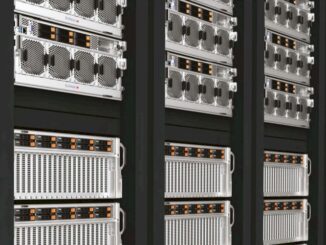
As we have said many times here at The Next Platform, the only way to predict the actual future is to live it. Despite that, people have a need to forecast because our guesses, prognostications, and hunches are what we base our plans on, and those plans collectively matrix multiply to generate the future that we inhabit.
This is why we keep track of the financials of key datacenter system suppliers as well as the forecasts from them and the independent forecasters like IDC and Gartner for broader IT trends. There are other key companies that play to niches that we keep an eye on, too. When you average them all out, throwing away the outliers, you can also use such IT forecasts as a means to figure out what kind of raise to ask for if you work in the IT department. And, while more and more of us are feeling this now in the age of GenAI, that spending has also correlated pretty tightly with the replacement rate of IT systems for jobs formerly done by people, too.
No one talked about that much, for obvious reasons, and we tell ourselves that people will move up the value chain and find more jobs or be more efficient or whatever. But honestly, some people never will find good work again, and that forecast for spending on servers in particular and in IT in general might be the best way to forecast how hard knowledge workers and factory workers will see their wages impacted – both for their benefit but probably more often to their detriment – over the coming years.
This is just the way it is, and we will speak honestly about that but not harp. We are here to chronicle, as objectively as is possible under the circumstances.
For several decades now, ahead of the Dot Com boom that started in 1995, IDC had publicly released statistics about the server business, as did its rival Gartner. In the past several years, just when the server business was getting interesting as accelerated computing was going mainstream, both companies stopped giving out sales of servers by vendor, architecture, form factor, and other salient characteristics – to our great dismay. But more recently, IDC has been giving out some information here and there, and this week it has put out an interesting server forecast that runs from 2025 through 2029 that is perhaps more realistic than some of the other forecasts we have seen.
The forecast from IDC reflects the enormous sums that have been promised for hyperscale AI systems with hundreds of thousands of XPUs each that various organizations have promised to spend before the end of the decade. Think of the Stargate project being spearheaded by OpenAI, what xAI is doing, or the various projects being funded by rich countries in the Middle East that want to diversify their holdings outside of the oil industry.
In its latest Worldwide Quarterly Server Tracker report, IDC says that companies bought a stunning $95.2 billion in servers in the first quarter of 2025, which was a 134.1 percent increase over sales in the first quarter of 2024, which added up to $40.7 billion. That Q 2025 growth was up 23.1 percent sequentially from the $77.3 billion of servers that shipped in Q4 2024, and this is in a market where the first quarter of a new year almost always has much weaker sales than the last quarter of the previous year because year end is when IT budgets turn. (If you don’t use the IT budget, you lose it, and that fact creates the artificial wave that shows Q2 and Q4 usually doing better than Q1 and Q3.)
Here is the pretty chart that IDC put out as its forecast:
We are thankful that the market researcher put some rounded figures on the 2024 and 2029 bookends of this data so we could use pixel counts in the chart to estimate the sales in 2025 through 2028. Like this:
As usual, the items shown in bold red italics are estimates by The Next Platform.
In the table, we consolidated the Other architecture platforms into one category. You can see Other Non Accelerated systems, which is mostly IBM’s Power Systems and System z big iron platforms, which admittedly are noise in this data even if they generate billions of dollars in very profitable revenues for Big Blue every year because IBM created and controls the entire platform stack for these systems. (Although Oracle and SAP drive a big portion of its legacy AIX database serving business.) Other Accelerated Systems is an even smaller slice, barely visible at all.
We also called these XPU servers rather than accelerated servers, and to be fair, both IBM System z and Power Systems machines have integrated matrix math units for doing AI. These lines are hard to draw.
The IDC server forecast just put out is interesting in that it separates X86 server iron from ARM server iron and also those servers that have accelerators from those who do not. Here is the breakdown of X86 versus Arm servers:
And here is X86 and Arm servers that have been muscled up with some sort of XPU accelerator:
Obviously, there are far more shipments of plain vanilla servers that there are of accelerated servers, but with one or two and sometimes four or eight processors or once in a blue moon sixteen processors, they still don’t add up to the cost of a machine with eight GPUs – unless you are talking about IBM System z and Power Systems, which can also cost millions of dollars per rack. Big NUMA CPUs cost big money just like Big NUMA GPU iron does.
IDC says that it expects for the X86 server market overall (including those with XPUs added as well as those without them) to grow by 39.9 percent to $283.9 billion in 2025, with other non-86 iron accounting for $82 billion in sales, up 63.7 percent. Nvidia’s “Grace” GPUs, which are embedded in its AI system designs, are part of that growth, but so is the use of homegrown Arm server CPUs by the hyperscalers and cloud builders of the world. Servers with GPUs will see sales grow by 46.7 percent in 2025, says IDC, and will come close to half of all server revenues worldwide this year. Arm-based servers will see revenue grow by 70 percent this year and will account for 21.1 percent of shipments.
There was not much more detail given out by IDC. No vendor breakdowns, which is sad. No overall shipment numbers. Again, sad. If you want that data, you need a checkbook.
Just for fun, we compared and contrasted this IDC server forecast, which included both XPU accelerated machines as well as plain vanilla CPU machines, against the AI accelerator forecast from AMD and the implied system revenues that could be driven by those AI accelerator sales.
AMD gave the AI accelerator estimates, which we detailed here and backed out from a chart presented by company chief executive officer Lisa Su at the recent Advancing AI event in San Jose. Given this AI accelerator total addressable market (TAM), we estimated a total server TAM for these AI machines. This is admittedly a rough kind of number we have generated, but we think it is important to illustrate that absolutely huge amount of AI system sales the AI accelerator TAM implies. When you do the math on what AMD showed, it looks like $88.4 billion in AI systems were sold in 2023, and that this will grow by a factor of 12.8X to $1,131 billion in 2028.
The AMD and IDC models track a little in 2024 and 2025, and possibly did in 2023 if you extrapolate backwards and might have even converged in 2023. But after 2025, the huge gap between the IDC server model and server sales implied from the AI accelerator TAM given out by AMD most recently diverge by a lot, as you can see in the chart above. If you look at the table, you will see that AMD’s AI accelerator TAM is even bigger than IDC’s overall server sales from 2026 onwards.
It is hard to say who is right. But we will find out soon enough.
Comments are closed.










“AMD gave the AI accelerator estimates, which we detailed here and backed out …”
The link for “here” is not active at this time, could you edit to add it please?
Link fixed. Sorry about that.
It is here: https://www.nextplatform.com/2025/06/17/picking-apart-amds-ai-accelerator-forecasts-for-fun-and-budgets/